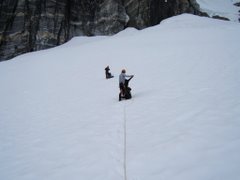Dear Glaciers,
I must profess my love to you, but awkwardly, I'm not sure where to begin or end. Do I start when I first met you at 17? The suddenness of being strapped to a bunch of strangers made into friends simply by gliding across your back. This trusting of my life to them and then later to you.
Or do I define our relationship by moments of overcoming cold, fear, or scientific roadblocks? Is hauling a golfbag full of snow up a mountain really a poignant sonnet? Did each blistered step lead to my love or this vocation? Love and job are intertwined now. Hours spent analyzing your blood, reading studies, making graphs, facing rigorous review. While these seem like important tasks of our relationship, I feel myself reconsidering the best way forward. A louder voice is needed.
No, I'm sure that I should define this love as something bigger than between you and me. Something celestial or geologic. My backyard in Ohio stands on 20 cm of fertility that formed directly from the vitamined rocks left behind during your retreat. Entire nations have food security from soils formed after the ebb of your ice in response to the orbital path of the sun. Before you created our fertile civilization upon which humanity rose, you pressed back and forth. You stayed in sync with the inner engine of our earth, the movement of plates and the weathering of rocks. These things are well studied, your mysteries unveiled.
Some of you will not be saved, but I am optimistic that others will. This is the greatest possibility. So much energy is spent by scientists, artists and advocates to understand and speak up for you. The momentum grows. My children Alex (8) and Vivian (6) deserve a planet that will care for them as they care for it. My love for you is the same fabric that covers them.
I head home from this icefield renewed in my commitment to you. I'll be an advocate, a teacher, and someone who keeps you in my heart. I'll fight for you and for us.
Love Always,
Sarah




















































